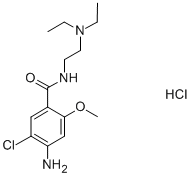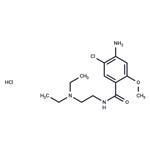
Metoclopramide hydrochloride
- Product NameMetoclopramide hydrochloride
- CAS7232-21-5
- CBNumberCB4236007
- MFC14H23Cl2N3O2
- MW336.26
- EINECS206-662-9
- MDL NumberMFCD00058011
- MOL File7232-21-5.mol
- MSDS FileSDS
Chemical Properties
| Melting point | 171-173°C |
| storage temp. | 2-8°C |
| solubility | H2O: soluble |
| form | solid |
| color | white |
| Water Solubility | H2O: soluble |
| NCI Dictionary of Cancer Terms | Reglan |
| FDA UNII | 7B1QZY5SWZ |
| NCI Drug Dictionary | Reglan |
| UNSPSC Code | 41116107 |
| NACRES | NA.77 |
Safety
| Symbol(GHS) |

|
|||||||||
| Signal word | Warning | |||||||||
| Hazard statements | H302 | |||||||||
| Precautionary statements | P264-P270-P301+P312-P501 | |||||||||
| Hazard Codes | Xn | |||||||||
| Risk Statements | 22-36/37/38 | |||||||||
| Safety Statements | 26-36 | |||||||||
| WGK Germany | 3 | |||||||||
| RTECS | BZ3325000 | |||||||||
| HS Code | 29242990 | |||||||||
| NFPA 704: |
|


